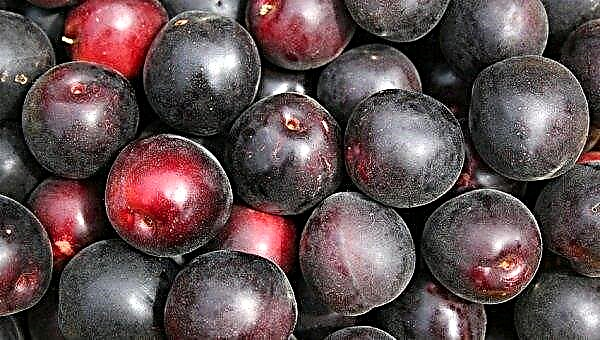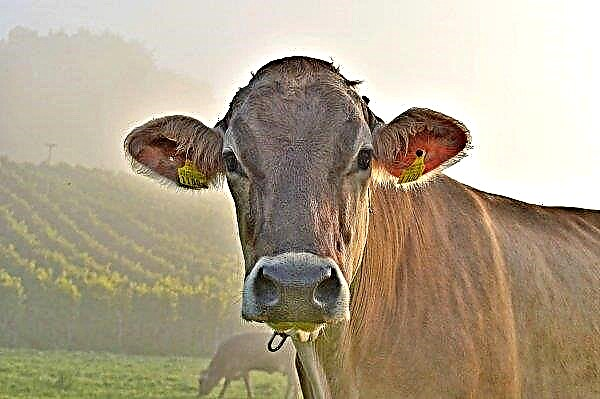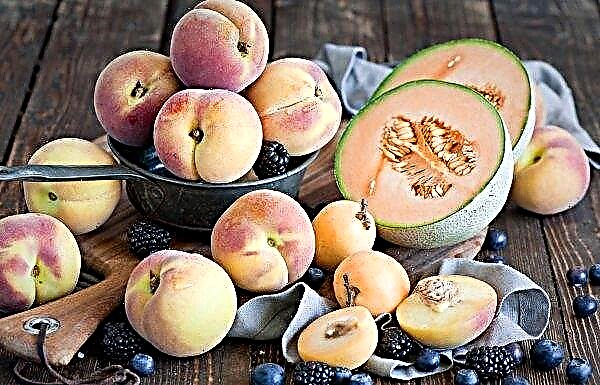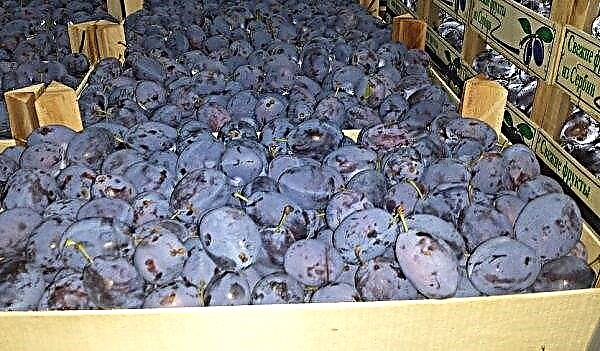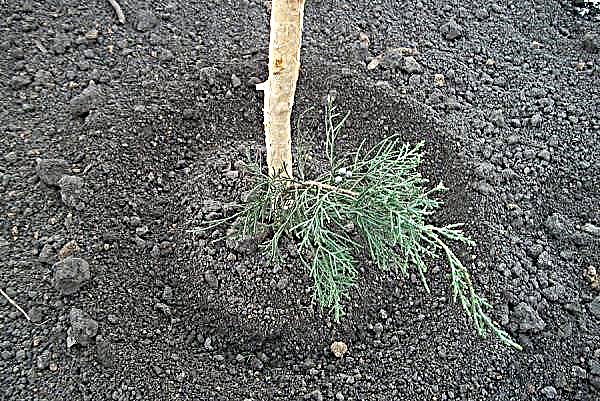Cannibalism in chickens is a behavioral deviation of birds, which is accompanied by plucking feathers from each other, pecking the inflamed skin around the oviduct, cloaca. It is more common in adults, less often in chickens aged twenty to sixty days. To avoid a massive reduction in the chicken population, it is necessary to identify the causes of the pathology and eliminate them: how to do this, we will consider in the article.
Why do chickens peck each other
Rasklev is a chicken’s reaction to a stressful situation caused by external factors, namely the conditions of keeping and feeding domesticated birds. You should understand what causes the aggressive behavior of poultry - highlight the main reasons:
- Poorly balanced, poor-quality feed: lack of greens in the diet, insufficient amount of protein in the feed mixture.
- Cramped space that does not allow birds to move freely.
- Excessive lighting, daylight hours.
- Poor ventilation, insufficient humidity.
- Lack of water.
- Worms. Infection of the laying hen occurs through poor-quality feed, non-compliance with sanitary standards for poultry.
Did you know? Chickens with dark plumage are less likely to show signs of cannibalism than white ones.
The presence of one or more reasons will lead to the emergence of biting in chickens. The maximum aggression of birds can be manifested as follows: a weak individual is pecking constantly, even to death. Cannibalism can manifest itself differentially, that is, chickens will peck relatives in such areas of the body - head and neck, limbs, cesspool and oviduct, etc.
In the tail
To pluck the chicken tail relatives:
- breed features. The presence of one culprit of cannibalism indicates deviations of this particular individual. You can solve the problem by simply isolating the aggressor from the herd;
- deficiency or absence of selenium - trace element contained in eggs and supporting the immune system. The introduction of selenium-containing premixes into the diet (a few top dressings within a month and a half is enough) will help eradicate the cause. Preventive treatment is carried out starting from the day old chickens - once every one and a half decades, and subsequently - once a month;
- metabolic disease. It is enough to periodically add stimulant drugs to drink.

In the head and neck
In the herd of birds, there are always dominant and subordinate individuals. Overpopulation of the chicken coop can lead to biting of the heads and necks of birds to blood. The reasons for this:
- the struggle for a dominant place in the herd is often accompanied by the bite of the male heads and necks of each other. The proportional distribution of males and females in the cells helps to completely eliminate this type of cannibalism;
- inactivity of livestock indoors, most often in winter. Loose litter with the addition of grass, sawdust, sand, scattered slices of pumpkin, corncobs, grain, pieces of aerated concrete allow the bird to further dig, moving around the chicken coop;
- the presence of parasites - ticks, lice. Sanitary treatment of the chicken coop, a complete change of litter, treatment of bird flocks will destroy the parasites, preventing biting.
Toes and skin
Fingers, the skin of the legs between them are common objects in chicks. Less noticeable damage, compared with plucking the feather cover, can have the same deplorable results. Factors that cause bending of the skin of the lower extremities:
- poor access to feed caused by an excessive number of chickens. It is necessary to increase the number of feeders, containers for drinking;
- lack of protein in the feed. It is necessary to balance the nutrition of poultry by adding meat and fish waste, bone meal, amino acid supplements rich in B vitamins;
- boredom. Alfalfa straw, husk, pebbles, pebbles added to the litter will solve several problems - they will prevent biting, balance the diet with vegetable proteins and fiber, and will entertain the inhabitants of the chicken coop.

To cesspool
The most dangerous type of biting, accompanied by the extermination of the livestock of poultry - biting of cloaca and oviduct. The chicken that was attacked is killed if it is not isolated from the herd in time. Identifying the causes of behavioral deviations in chickens helps to stop the epidemic in time:
- Improper poultry conditions, poor sanitary standards can cause mechanical damage, which is accompanied by the appearance of blood droplets, leading to cleavage. Proper planting of chickens, timely cleaning of the territory, checking the litter for mechanical traumatic objects will help eliminate the risk factor for cannibalism.
- Rigid food in young individuals, which begin to spread, will lead to injuries of the rectum. They, in turn, will entail external wounds, provoking relatives to bending. A responsible attitude to the selection of the physical composition of the feed, the addition of greens, the correct drinking regimen will help avoid wounds on the chicken cesspool, reducing the risk of biting to zero.
- The lack of trace elements in chickens during the period of plumage change. Chicks begin to pick up fluff, feathers that fell from others. Gradually, the behavior of the bird massively becomes aggressive. Chickens peck a weak companion to death. At the same time, the digestion of the cannibals is disturbed. The number of birds is declining sharply. Noticing the eating of feathers by chickens, it is necessary to balance the nutrients in the feed, preventing the appearance of cannibalism.
- The underweight young chicken, excessive light stimulation during spacing can lead to prolapse and injury to the oviduct. In this case, bleeding causes cannibalism in other individuals. You can prevent the disease by reducing the amount of light, closing the lights with colored shades, and windows with a film (or painted blue). Thus, by limiting the visual possibilities of the chicken (the bird does not see wounds in the neighbors), it is possible to reduce the risks of biting.
Important! The daily rate of green feed for laying hens is 20% of the total feed mass.
Clinical signs
Many poultry farmers consider the lack of protein in feed to be the main cause of cannibalism in domestic chickens. In addition, a large number of livestock per square meter of the paddock, the absence of green food, low humidity can lead to biting birds. You can avoid the aggressive behavior of chickens by carefully observing the behavior of the birds in the pen and highlighting the following symptoms:
You can avoid the aggressive behavior of chickens by carefully observing the behavior of the birds in the pen and highlighting the following symptoms:
- Lack of fluff and feathers in the pen during the change of plumage in young animals.
- The chicken, prone to cannibalism, becomes nervous, pecks not only herd comrades, but everyone around.
- A laying hen begins to peck eggs (his own and others), gradually switching to weaker neighbors.
- Frequent fights of young roosters, accompanied by injuries, provoke bends. At the same time, even hens attack the victim.
Did you know? Cannibal roosters are not attack on chickens. Hens are able to inflict wounds on both sexes.
What to do with cannibalism in chickens?
Adult chickens show a tendency to cannibalism quite rarely. It is practically impossible to treat the “aggressor”. The most effective way is to send the bird under the knife. The stock of young animals can be eliminated from biting by identifying the cause and eliminating it:
- A sharp change in feed. Switching from expensive to cheap feeds containing fewer minerals, proteins, can lead to bird disease. A properly selected diet, a balanced content of vitamins, minerals, a constant intake of green food will help prevent negative behavior of chickens.
- The right lighting. Hens respond well to color. Yellow and red, orange lamps will increase egg production. Green and blue lighting will accelerate the growth of layers, inhibiting puberty. The most optimal lighting: matte white or blue. Windows in the presence of bright daylight should be painted in dark color or closed with curtains, blinds, opening only at night.
- Ventilation. Stagnation of air in the pen leads to a decrease in humidity. The presence of a sufficient number of drinking bowls, free access to them, ventilation shafts in the right amount, exclude the manifestation of cannibalism in chickens and young animals.
- Lack of entertainment. So that chickens do not show aggression from an early age, they need to find something to do with it. The chicken must constantly peck something. By adding salt to the water, they increase the feeling of hunger in the bird. Grain, pebbles, pieces of pumpkin and aerated concrete scattered over the litter allow the poultry to move additionally.
- Availability of walking. Experienced poultry breeders say: by providing a pad for walking, you can avoid the main problems of poultry rearing - this is an early case and biting.

Treatments for affected birds
An aggressive individual is capable of causing significant damage to the bird population, pecking other chickens to blood and thereby provoking a deviation in the behavior of other members of the herd.
Did you know? In the states of Europe, an official ban on the debiking (trimming of the beak) of poultry has been introduced.
It is best to isolate the ringleaders from the bulk of the birds by treating the victims:
- Treat wounds with an antiseptic solution. The best remedy is Diamond Green. It simultaneously dries up the wound, stops bleeding and eliminates the provocation of further biting.
- The most pecked chicks must be completely removed from the pen, placed in a separate room.
- Carefully review the diet of poultry by adding the necessary substances, grain with a maximum capacity of fiber.
- Check the premises for possible mechanical damage: protruding nails, broken glass, wire.

Preventive measures against biting
- Proper nutrition: correctly calculated quantity and quality of feed. The presence of the necessary minerals, protein, sufficient fiber capacity.
- Spacious cells. Overpopulation of the pen by 10% can increase bird pest by 40-50%.
- A sufficient number of feeders and drinking bowls, the constant presence of food and water in the cells.
- Optimum humidity and ventilation in the room.
- Lack of bright lighting for a long time, especially during the distribution of young fish.
- Availability of a platform for walking. The free movement of chickens promotes rapid growth, better development.
- Suspended bundles of tops of vegetables and greens will help to remove aggression.
- Beak pruning. An extreme measure that is rarely resorted to. Debicking is done in young chickens. It also helps prevent feather plucking caused by stress.
Important! By adding hard particles to the feed - sand, small pebbles, it is possible to achieve a natural pruning of the beak: its sharp tip is draining.
Cannibalism is an atypical behavior of domestic birds. Keeping, feeding, free space in proper proportions will completely exclude chickens biting.




